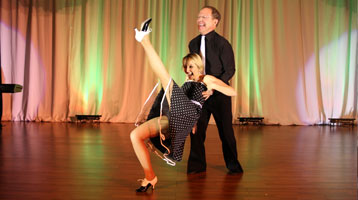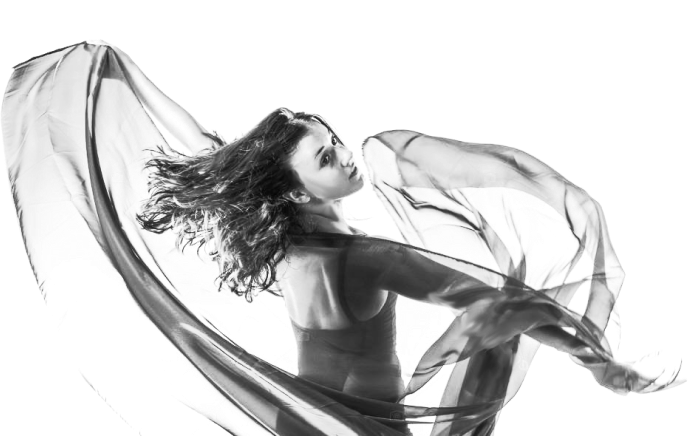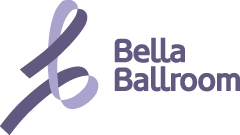
Swing Dance
Jitterbug
The jitterbug is a generalized name used to describe various types of swing dancing. The jitterbug might include elements of the Lindy Hop, East Coast Swing, West Coast Swing, Charleston, Shag, Jive, or Balboa.
History of the Jitterbug:
The Jitterbug is a type of dance that became popular is the 1930s and is associated with various types of swing dances like the Lindy Hop, Jive and East Coast Swing. Jitterbug is typically used as a general term to describe the dancing of the big band and swing dancing eras. The name “jitterbug”comes from a slang term for alcoholics who suffered from the “jitters” and the name became associated with swing dancers who danced “out of control” with all of their jumping, spinning and cutting loose. Eventually, it became a way to describe all swing dancers and jitterbug developed into another name for the dance. The term became especially popular in 1934. Jazz singer Cab Calloway recorded “Call of the Jitter Bug” in 1934 and the film “Cab Calloway’s Jitterbug Party” was released popularizing the term “Jitterbug” even further. The lyrics of the song “Call of the Jitter Bug” drew a strong association between the Jitterbug and the consumption of alcohol:
“If you’d like to be a jitter bug, first thing you must do is get a jug, put whisky, wine and gin within, and shake it all up and then begin. Grab a cup and start to toss, you are drinking jitter sauce! Don’t you worry, you just mug, and then you’ll be a jitter bug!”
The swing style of the Jitterbug originated in African American dance clubs in Harlem, New York and surrounding areas. On March 26, 1926 the Savoy Ballroom opened its doors in New York, three years after the infamous Cotton Club Jazz Club opened. The Savoy became a huge and immediate success, as its dance floor was as long as a city block. It had a raised double bandstand and attracted many of the best dancers of New York City and the surrounding areas. Frequented by many great dancers and the best of bands, the Savoy became a huge swinging Jazz club where one could see the most cutting edge dances moves of the time.
The Jitterbug dance became very popular with the African American community, especially in the Harlem nightclubs of New York City. Dancers incorporated movements from their African heritage, which included quick legwork and very mobile upper body movement. Cab Calloway’s song “Cab Calloway’s Jitter Bug Party” brought the Jitterbug to the forefront of the public eye causing it to spread quickly beyond the African American community, across the United States and eventually to Europe.
The Jitterbug became very popular in the 1940s just before World War II and the swing craze continued throughout wartime. American GIs spread the jitterbug dance to Europe despite European officials calling the dance uncivilized. While many skeptics said that the Jitterbug dance craze would never last, the dance became very popular throughout the United States and Eastern Europe during World War II. The Jitterbug dance has survived throughout the years and remains a true social dance staple with the dance communities of today.
Jitterbug Dance Today:
The Jitterbug is still danced and celebrated by dance communities around the world. The Jitterbug continues to keep its legacy as the granddaddy of slam dancing yet is often grouped under the name of other Swing dances. The Charleston, the Lindy Hop, the Shag, and the Black Bottom are considered styles of Jitterbug dancing.
When the Rock and Roll craze put swing music on the backburners in the 1960s, a new type of “Jitterbug” began to brew on the East side of Detroit that became known as the “Jit.” The new Jit evolved mostly as a solo improvisation dance showcasing fancy footwork tracing back to Jitterbug styles of dance. The Jit evolved to incorporate the universal basic footwork of standing on one foot with the other leg raised at the shin or knee twisting the knee back and forth in a game of balance with accompanying subtle arm movements. Detroit dance groups who performed in competitions and club venues throughout the city also developed dance routines. The Jit grew to include power moves like aerial tricks and hip-hop’s moves stemming from popping and locking. The Jit was featured on TV programs gaining the style some fame nationally and internationally. While the Jit has died down in popularity and practice, Mike Manson That Be Dancin featured the Jit on national dance competition television show So You Think You Can Dance during the Detroit auditions.
The Jitterbug is featured at dance camps, dance competitions, swing dance workshops, and festivals every year. Swing dance festivals and camps allow dancers to exchange dance ideas and continue the evolution of Swing dancing. The Jitterbug continues to be used as a social dance, a competition dance, and a performance dance.
Jitterbug Songs:
- “Boogie Woogie Bugle Boy” Andrew Sisters
- “At the Hop” Danny & the Juniors
- “Choo Choo Chaboogie” Manhattan Transfer
- “Rock This Town” Stray Cats
- “Baby Likes to Rock It” The Tractors
- “Swing the Mood” Brian Setzer Orchestra
- “Jailhouse Rock” Elvis
- “Rock Around The Clock” Bill Haley and Comets
- “Jump Jive and Wail” Brian Setzer
- “Zoot Suit Riot” Cherry Poppin’ Daddies
- “In the Mood” Glen Miller Orchestra
- “I Wanna Be Like You” Big Bad Voodoo Daddy
- “Rock This Town” The Stray Cats
- “You and Me and the Bottle Makes Three” Big Bad Voodoo Daddy
- “Pensylvania 6-5000” Glen Miller Orchestra
- “Rockin’ Robin” Bobby Day
- “That’ll Be the Day” Buddy Holly
- “Shake Rattle and Roll” Bill Haley & Comets
- “Boogie Woogie Bugle Boy” Company B
- “Bye Bye Love” Everly Brothers
- “Wake Up Little Suzy” Everly Brothers
- “See You Later Alligator” Bill Haley
- “Splish Splash” Bobby Darin
- “All Shook Up” Elvis Presley
- “Blue Suede Shoes” Elvis Presley
- “Run Around” Sue Dion
- “Rock and Roll Music” Chuck Berry
- “Rockin’ Robin” Bobby Day
- “Johnny B Good” Chuck Berry
- “Great Balls of Fire” Jerry Lee Lewis
- “Tutti Frutti” Little Richard
- “At the Hop” Danny & the Jrs
- “La Bamba” Los Lobos
- “In the Mood” Glen Miller
- “Lovers Who Wander” Dion
- “Chantilly Lace” Big Bopper
- “Come On Lets Go” Los Lobos
- “Ability to Swing” Thomas Dolby
- “Think” Aretha Franklin
- “Rocket 88” Jackie Brenston
- “Jive After Five” Carl Perkins


